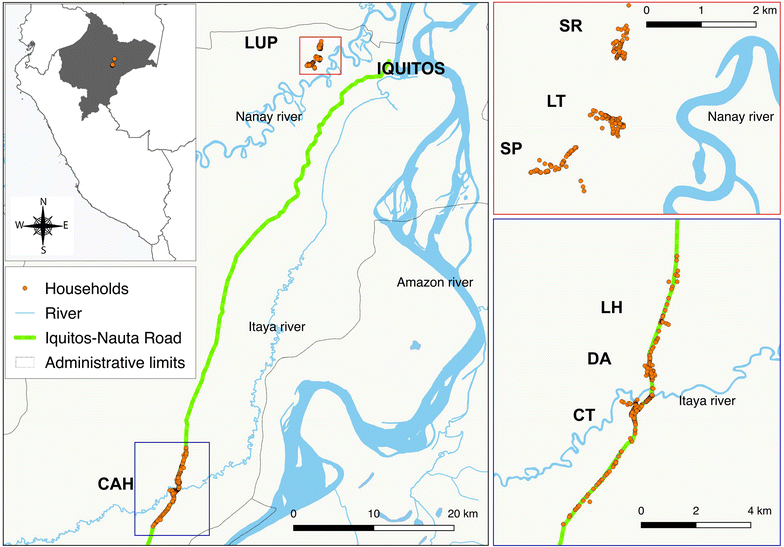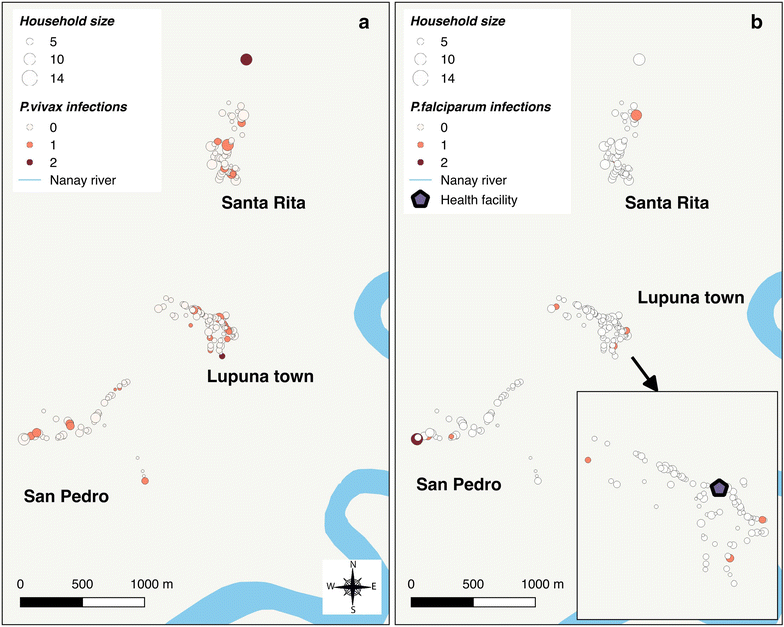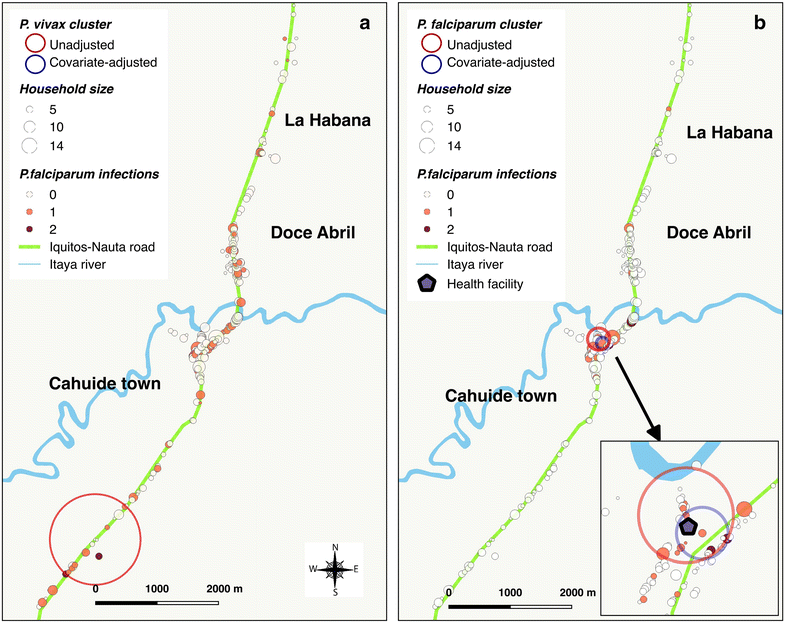Micro-heterogeneity of malaria transmission in the Peruvian Amazon: a baseline assessment underlying a population-based cohort study
- PMID: 28778210
- PMCID: PMC5544973
- DOI: 10.1186/s12936-017-1957-y
Micro-heterogeneity of malaria transmission in the Peruvian Amazon: a baseline assessment underlying a population-based cohort study
Abstract
Background: Understanding the dynamics of malaria transmission in diverse endemic settings is key for designing and implementing locally adapted and sustainable control and elimination strategies. A parasitological and epidemiological survey was conducted in September-October 2012, as a baseline underlying a 3-year population-based longitudinal cohort study. The aim was to characterize malaria transmission patterns in two contrasting ecological rural sites in the Peruvian Amazon, Lupuna (LUP), a riverine environment, and Cahuide (CAH), associated with road-linked deforestation.
Methods: After a full population census, 1941 individuals 3 years and older (829 in LUP, 1112 in CAH) were interviewed, clinically examined and had a blood sample taken for the detection of malaria parasites by microscopy and PCR. Species-specific parasite prevalence was estimated overall and by site. Multivariate logistic regression models assessed risk factors for parasite infection by PCR, while SaTScan detected spatial clusters of PCR-positive individuals within each site. In addition, data from routine malaria surveillance in the period 2009-2012 were obtained.
Results: Parasite prevalence by PCR was higher in CAH than in LUP for Plasmodium vivax (6.2% vs. 3.9%) and for Plasmodium falciparum (2.6% vs. 1.2%). Among PCR-confirmed infections, asymptomatic (Asy) parasite carriers were always more common than symptomatic (Sy) infections for P. vivax (Asy/Sy ratio: 2/1 in LUP and 3.7/1 in CAH) and for P. falciparum (Asy/Sy ratio: 1.3/1 in LUP and 4/1 in CAH). Sub-patent (Spat) infections also predominated over patent (Pat) infections for both species: P. vivax (Spat/Pat ratio: 2.8/1 in LUP and 3.7/1 in CAH) and P. falciparum malaria (Spat/Pat ratio: 1.9/1 in LUP and 26/0 in CAH). For CAH, age, gender and living in a household without electricity were significantly associated with P. vivax infection, while only age and living in a household with electricity was associated with P. falciparum infection. For LUP, only household overcrowding was associated with P. falciparum infection. The spatial analysis only identified well-defined clusters of P. vivax and P. falciparum infected individuals in CAH. Reported malaria incidence indicated that malaria transmission has long occurred in LUP with primarily seasonal patterns, and confirmed a malaria outbreak in CAH since May 2012.
Conclusions: This parasitological and epidemiological baseline assessment demonstrates that malaria transmission and parasite prevalence is heterogeneous in the Peruvian Amazon, and influenced by local socio-demographics and ecological contexts. Riverine and road construction/deforestation contexts must be taken into account in order to carry out effective anti-malaria control and elimination efforts.
Keywords: Heterogeneity; Hotspot; Malaria; PCR; Peruvian Amazon; Transmission.
Figures




Similar articles
-
Hotspots of Malaria Transmission in the Peruvian Amazon: Rapid Assessment through a Parasitological and Serological Survey.PLoS One. 2015 Sep 10;10(9):e0137458. doi: 10.1371/journal.pone.0137458. eCollection 2015. PLoS One. 2015. PMID: 26356311 Free PMC article.
-
Temporal and Microspatial Heterogeneity in Transmission Dynamics of Coendemic Plasmodium vivax and Plasmodium falciparum in Two Rural Cohort Populations in the Peruvian Amazon.J Infect Dis. 2021 Apr 23;223(8):1466-1477. doi: 10.1093/infdis/jiaa526. J Infect Dis. 2021. PMID: 32822474 Free PMC article.
-
High prevalence of very-low Plasmodium falciparum and Plasmodium vivax parasitaemia carriers in the Peruvian Amazon: insights into local and occupational mobility-related transmission.Malar J. 2017 Oct 16;16(1):415. doi: 10.1186/s12936-017-2063-x. Malar J. 2017. PMID: 29037202 Free PMC article.
-
Plasmodium vivax in the Era of the Shrinking P. falciparum Map.Trends Parasitol. 2020 Jun;36(6):560-570. doi: 10.1016/j.pt.2020.03.009. Epub 2020 Apr 22. Trends Parasitol. 2020. PMID: 32407682 Free PMC article. Review.
-
Plasmodium vivax - How hidden reservoirs hinder global malaria elimination.Parasitol Int. 2022 Apr;87:102526. doi: 10.1016/j.parint.2021.102526. Epub 2021 Dec 8. Parasitol Int. 2022. PMID: 34896312 Review.
Cited by
-
Malaria risk assessment and mapping using satellite imagery and boosted regression trees in the Peruvian Amazon.Sci Rep. 2019 Oct 23;9(1):15173. doi: 10.1038/s41598-019-51564-4. Sci Rep. 2019. PMID: 31645604 Free PMC article.
-
The spatial signature of Plasmodium vivax and Plasmodium falciparum infections: quantifying the clustering of infections in cross-sectional surveys and cohort studies.Malar J. 2023 Mar 4;22(1):75. doi: 10.1186/s12936-023-04515-4. Malar J. 2023. PMID: 36870976 Free PMC article.
-
Integrating Parasitological and Entomological Observations to Understand Malaria Transmission in Riverine Villages in the Peruvian Amazon.J Infect Dis. 2021 Apr 27;223(12 Suppl 2):S99-S110. doi: 10.1093/infdis/jiaa496. J Infect Dis. 2021. PMID: 33906225 Free PMC article.
-
Recurrence patterns and evolution of submicroscopic and asymptomatic Plasmodium vivax infections in malaria-endemic areas of the Peruvian Amazon.PLoS Negl Trop Dis. 2024 Oct 31;18(10):e0012566. doi: 10.1371/journal.pntd.0012566. eCollection 2024 Oct. PLoS Negl Trop Dis. 2024. PMID: 39480785 Free PMC article.
-
Asymptomatic/submicroscopic Plasmodium vivax infection: A systematic review and META-analysis on the hidden challenge for preventing re-establishment of malaria transmission.Parasite Epidemiol Control. 2025 Jun 15;30:e00442. doi: 10.1016/j.parepi.2025.e00442. eCollection 2025 Aug. Parasite Epidemiol Control. 2025. PMID: 40607277 Free PMC article.
References
-
- Cueto M. El regreso de las epidemias: salud y sociedad en el Perú del siglo XX. IEP; 1997.
Publication types
MeSH terms
Grants and funding
LinkOut - more resources
Full Text Sources
Other Literature Sources
Molecular Biology Databases

